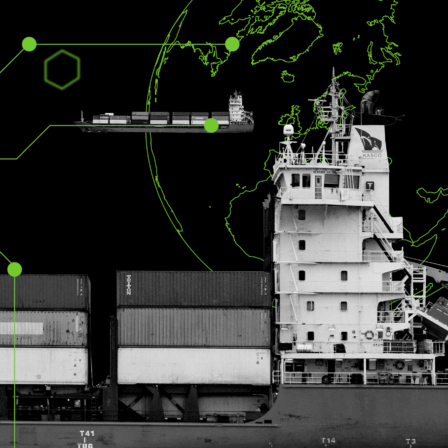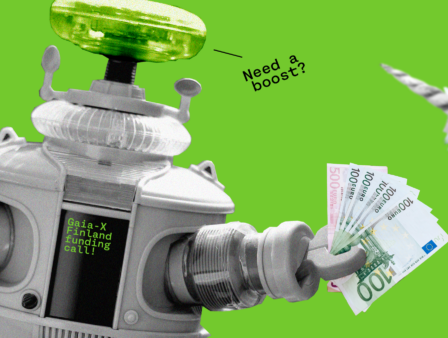As part of the Gaia-X Finland project, Sitra opened a co-funding call for pilot projects building data ecosystems. The goal for the call was to accelerate the understanding and adoption of Gaia-X principles by Finnish companies and learn how to enable data sharing within data ecosystems.
Gaia-X is a European initiative working toward establishing a global standard for data sharing based on a decentralised and open data infrastructure, where data can be shared within a data ecosystem or data space in a secured, governed, and trusted manner.
The call generated interest from over 800 potential applicants. Of these, about 60 consortia applied, and five projects were selected, representing over 23 companies.
Through this experiment, we were given a glimpse into the future of data space development in Finland and compared it to other leading countries, including Germany, France, the Netherlands, and Belgium.
The lessons learned from the data space pilot projects
1) Data ecosystem orchestration
It is crucial to have a neutral orchestrator facilitating the exchanges between participants before the operations and governance of a data ecosystem solidifies. At the community-building stage, priorities include identifying a common business goal, communicating the vision, and rallying others to join. The orchestrator should prioritise use cases, map business value creation, test business models, and set up governance models. During the operation phase, the focus will shift toward onboarding, enforcing the rules, ensuring the governance works as it should, and scaling up readiness.
2) Economic driver and business model
When selecting early use cases, the focus should be on a case that offers clear value to the participating companies. This work includes understanding and mapping the value chain and communicating with all participants and potential users of the new services, quantifying the market size and opportunities for new services or data products.
3) Power distribution and unequal profit
A governance model that is fair and equal for all sizes of organisations should be sought after. Where the profits are unequally shared among participants, this may discourage certain participants from contributing to building the data ecosystem. Consider having a mechanism or business model that redistributes the gains or takes into account other non-monetary drivers that motivate each organisation to participate.
4) New data product and distribution
The data ecosystems enabling participants to share data could lead to the founding of new services or data products. The data product development should be iterative and validated by users. Ensure that it solves a real challenge with an adequate business model and can be distributed and consumed by a data ecosystem.
5) Technical translator for past or future compatibility
Data ecosystem projects often have legacy systems, business processes, or datahubs. Consider the boundaries and integration needs to connect the data with the data ecosystem. A technical translator module may be needed if the data model, format, or structure is different. Similarly, if the data ecosystem serves participants in multiple countries, the system might need to consider the backward compatibility of existing contracts, notary requirements, and jurisdictions in respective countries. This would include a new rule module that accommodates or supersedes existing contracts, with an implementation and roll-out plan.
6) Governance beyond the data ecosystem
Governance of the data ecosystem is a prerequisite for building trust and transparency between all participants, with a clear structure and governance processes. The intent is to connect with other federated data ecosystems with the same data-sharing standards such as Gaia-X. Doing so could open up the governance of a single environment into multiple-party environments. This might require additional work to make existing governance models compatible.
7) Transition legacy API to a connector
Working on the data ecosystem often requires organisations to rethink their data-sharing strategy. This might include moving away from using a conventional application programming interface (API) for point-to-point connection to sharing data by using a connector that enables all parties to share data in an open and distributed manner. This enables interested parties to connect with the data ecosystem at any time.
8) The shift from pipeline to platform business
Data ecosystem development often goes hand-in-hand with the advanced digital transformation of a group of companies. The driving trend behind this is the need for organisations to shift from the traditional pipeline business model to a platform model. This is where buy-in from senior management is crucial. This empowers the participants to align these efforts with the strategic interest of their organisation.
Recommendations
Data ecosystem development is a continuation of the digitalisation journey. This involves progressing from the digitisation of processes or systems within a single company, to connecting with multiple companies forming an orchestrated data ecosystem of interconnected companies. The orchestrated data ecosystem can further connect with other ecosystems within the sector, across sectors, or across different geographical boundaries. When considering the strategic importance of such an effort, start early, gain hands-on experience by doing development work, and secure support from senior management early in the process.
Due to this advanced digital transformation, companies often need to acquire or develop new skills that do not yet exist in the organisation. For example, this could include the skills to work, lead, orchestrate a data ecosystem, build new services, carry out data product development, understand new business models, use the data ecosystem as a distribution channel, and master the different building blocks of the data ecosystem.
Such a transformation is often hard to comprehend if seen through the lens of traditional incremental or linear innovation. Similarly, comprehension is hindered if the innovation is seen only as an efficiency or productivity gain project. Nevertheless, real opportunities arise when a non-linear innovation mindset is adopted. This is where new products are created using previously unavailable data, previously inaccessible tools, or artificial intelligence agents. One outcome is often the creation of a new market or the disruption of an existing market. Such creative disruption is often a path littered with organisations that were once market-leaders, but have since gone into bankruptcy after missing a big market trend.
The pilot projects covered several cases
Finnish maritime data space Initiative
The goal was to develop new data products to reduce fuel consumption and CO2 emissions through the use of virtual queueing with Virtual Port Arrival (VPA), and optimise the speed of a vessel with Just-in-Time (JIT) arrival.
Participants: Awake.ai, E&S Tankers, Borealis Plastics, Siili Solutions, Fintraffic VTS, ESL Shipping, and the Port of Oxelösund, Sweden.
Potato-X agriculture data space initiative
One of the goals was to integrate three working environments for farmers to access machinery data from the machine manufacturer to improve the yield of their crops.
Participants: 1001 Lakes, DataSpace Europe, Flanders Research Institute for Agriculture, Fisheries and Food (EV-ILVO), AVR Belgium, the harvesting machinery, and Klåvus Group, and a group of potato farmers.
Skills data space initiative
The goal was to develop a new data product that uses artificial intelligence to benchmark and compare the skills needed within a company or sector and thus improve human resources planning and talent development.
Participants: Headai, Visions, Lightcast (Economic Modeling LLC), Prometheus-X, and ABB.
Air cargo logistics initiative
The goal was to identify business use cases that enhance the cargo operations at Helsinki Airport by sharing cargo dimensions data with all stakeholders to improve the use of cargo spaces and planning.
Participants: Fintraffic, Finnair Cargo, and Finnavia.
The consortia worked with Taival Advisory to enhance business value creation, map the value drivers, and explore possible business models.




